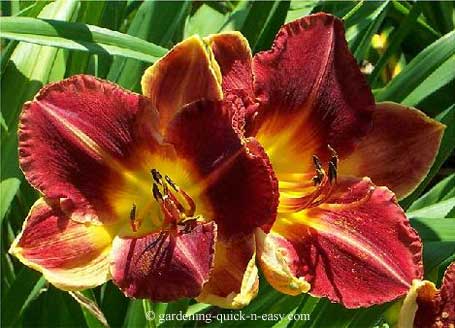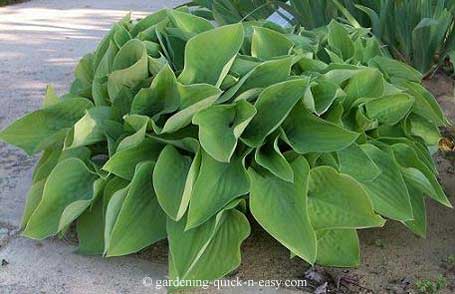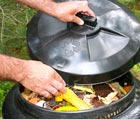- Gardening Tips |
- | What's NEW! |
- | Contact Us |
- | Sitemap
Plant Division Tips and Guidelines
Sometimes plant division may be necessary. This usually occurs if your garden items overgrow the original area you had planned for them.
Dividing plants and flowers will help keep your garden areas looking fresh, strong and healthy all season long. To do your dividing quick 'n easy, remember to:
- divide late summer and fall blooming varieties in spring
- divide spring blooming varieties in fall
This will give your plants a full season to become reestablished before they bloom again. If possible, the day before you plan to divide them, water the flowers and plants you'll be working with. Try to plan on dividing and transplanting on a cool, cloudy day to minimize stress on the plants.
Check below for specific information about plant division for the items from the Easy Care Plants page:
Daylilies:
After about four or five years of growing in your garden, your daylilies may need dividing in order to allow flowering to continue to flourish.
 Daylily 'Calgary Stampede'
Daylily 'Calgary Stampede'
- late summer is the best time to divide daylilies
- dig around and lift individual clumps
- using a sharp knife or shovel, separate the large clump into 4 or 6 smaller clumps
- select healthy young clumps of plants with strong root systems (healthy roots are typically white or cream colored)
- discard any small or diseased plants
- cut back the foliage (leaves) and replant immediately in good soil or place in containers
- replant the new sections
- dividing your daylilies will give you plenty of extra plants ... enough to share with friends and neighbors too!
Hostas:
Hostas remain vigorous without division and become more beautiful as they grow.
 Hosta 'Gold Edger'
Hosta 'Gold Edger'
If your hostas do overgrow their setting though, you'll need to consider dividing the mature clumps.
- early spring, when new growth just begins to show, is the best time to divide Hostas
- dig around and lift the large clump
- using a sharp knife or shovel, separate the large clump into 4 or 6 smaller clumps
- shake off most of the soil and pull the clumps apart making sure each division has a good cluster of leaves and plenty of healthy roots
- replant and be sure to leave plenty of space for the new growth
Iris:
Dividing iris every three to five years will keep your iris bed healthy and looking well-groomed.
- late summer or early fall are the best times to divide
- dig up the plant using a shovel, being careful not to damage the rhizomes (bulbs)
- each division should have one or more 2" - 6" sections with leaves and healthy white roots
- discard the old center piece of the rhizome (bulb) or any part of the plant that looks damaged
- replant the new sections
Ornamental Grasses:
- place two pitchforks back to back or use some other method to pry the plant clump's roots apart
- separate into divisions
- remove any dead or diseased plant parts and cut back stems
- replant them just as you would new potted plants
- replant one division where the plant was originally and plant the extra divisions elsewhere in your garden
- plant the divisions immediately, or as soon as possible, and water well
Regular plant division will keep your garden areas looking fresh and well-maintained ... and will keep you (and your neighbors) well-stocked with strong, healthy flowers and plants.
Related Information:
Garden Plant Support or Staking
To Top of this Plant Division page
Return to Gardening Tips Home Page
Gardening Updates
Note: We'd love you to send us your favorite garden pics to feature on our new pages!
Contact Us and we'll send you an email address that can accommodate your photographs.

